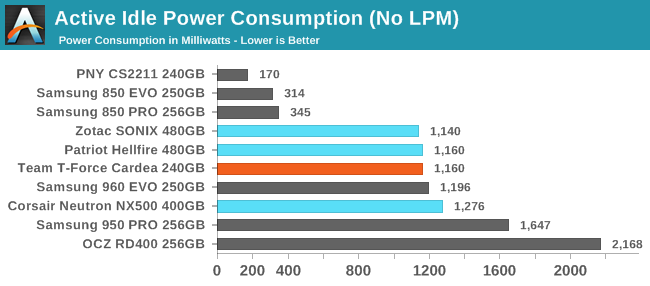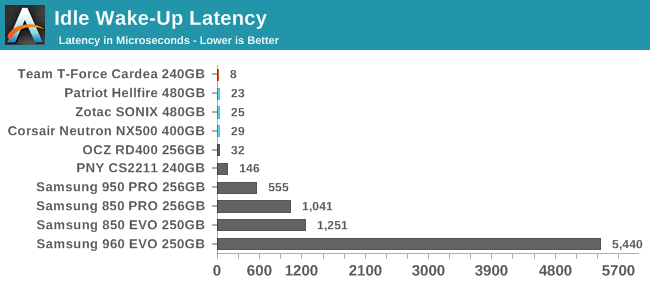The Team Group T-Force Cardea (240GB) SSD Review: Grace Under Write Pressure
by Billy Tallis on September 28, 2017 8:00 AM ESTPower Management
Real-world client storage workloads leave SSDs idle most of the time, so the active power measurements presented earlier in this review only account for a small part of what determines a drive's suitability for battery-powered use. Especially under light use, the power efficiency of a SSD is determined mostly be how well it can save power when idle.
SATA SSDs are tested with SATA link power management disabled to measure their active idle power draw, and with it enabled for the deeper idle power consumption score and the idle wake-up latency test. Our testbed, like any ordinary desktop system, cannot trigger the deepest DevSleep idle state.
Idle power management for NVMe SSDs is far more complicated than for SATA SSDs. NVMe SSDs can support several different idle power states, and through the Autonomous Power State Transition (APST) feature the operating system can set a drive's policy for when to drop down to a lower power state. There is typically a tradeoff in that lower-power states take longer to enter and wake up from, so the choice about what power states to use may differ for desktop and notebooks.
We report two idle power measurements. Active idle is representative of a typical desktop, where none of the advanced PCIe link or NVMe power saving features are enabled and the drive is immediately ready to process new commands. The idle power consumption metric is measured with PCIe Active State Power Management L1.2 state enabled and NVMe APST enabled.


As with the other Phison E7 drives, the Team T-Force Cardea has a compatibility problem with out testbed when it comes to power management. Since the T-Force Cardea is intended as a desktop-only product, the overall power consumption is a very minor concern, and the heatsink eliminates any concerns about a higher idle temperature making the drive more susceptible to thermal throttling under load.

With power management that is inoperative on our testbed, none of the Phison E7 drives show more than a trivial delay when first given I/O commands after an idle period. By contrast, the Samsung 960 EVO needs an extra 5ms to come out of its sleep state.










22 Comments
View All Comments
MajGenRelativity - Thursday, September 28, 2017 - link
While this drive doesn't seem too interesting, I'm very interested in your upcoming review on M.2 Thermal Throttling!Pinn - Thursday, September 28, 2017 - link
You should see it by using ~10G files and a ram drive. The Intel card SSD is much more consistent than the M.2 sticks I've tried.Dr. Swag - Thursday, September 28, 2017 - link
Did you guys change some things? Because it feels like some of the results are different, as I remember the 960 evo doing a lot better before...evilspoons - Thursday, September 28, 2017 - link
These results only include the 250 GB 960 Evo, which is the bottom of the line for the 960 series. IIRC the controller is kneecapped due to having a minimum number of NAND chips available and has no parallel processing ability... hence why reviews like this are interesting!Billy Tallis - Thursday, September 28, 2017 - link
Yep. Our initial review of the 960 EVO only included results from the 1TB model, because our first 250GB sample died during testing. The replacement has been working fine, but its performance profile is very different from the 1TB.The relationship between performance and capacity was the biggest reason I wanted to review this drive; it was the first 240GB Phison E7 sample offered to us.
mapesdhs - Thursday, September 28, 2017 - link
It's shocking how much better than 950 Pro is over the 960 EVO a lot of the time. Other reviews show the EVO has issues with steady state performance even at higher capacities. It's why I bagged a lightly used 950 Pro 512GB recently; noticed someone else no doubt delighted at getting another for 130 UKP BIN. :D And of course, the 950 Pro has its own boot ROM (why the heck did Samsung ditch that? Such a useful feature for older chipsets).CheapSushi - Sunday, October 1, 2017 - link
There's an inherent performance and latency difference between MLC (Pro) and TLC (EVO) NAND. Even with updates, better controllers, etc, it is always there (2 bits per cell vs 3 bits per cell).Dr. Swag - Thursday, September 28, 2017 - link
Ah I see. Interesting to see such a large performance gap, though I guess it makes sense.Gasaraki88 - Thursday, September 28, 2017 - link
I wonder why you guys never reviewed the MyDigitalSSD BPX. It's one of the fastest Phison E7 controller SSDs and the cheapest.DanNeely - Thursday, September 28, 2017 - link
MyDigitalSSD would have to send one in for review...